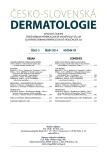Structure and Function of Eccrine Sweat Glands and Possibilities of Perspiration Control
Authors:
R. Litvik 1,2
Authors‘ workplace:
Kožní oddělení Fakultní nemocnice Ostrava
primářka MUDr. Yvetta Vantuchová, Ph. D.
1; Centrum plastické chirurgie a chirurgie ruky Fakultní nemocnice Ostrava
primář MUDr. Bronislav Vřeský
2
Published in:
Čes-slov Derm, 89, 2014, No. 5, p. 215-223
Category:
Reviews (Continuing Medical Education)
Overview
Eccrine sweat gland produce a secret devoid of cytoplasmic constituents. The sweat is the less concentrated body fluid and its composition is individual not only in concentration but also in the biochemical composition. Sweating is important for termoregulation, horny layer hydration and excretion of toxic substances. Localized increased sweating (focal hyperhidrosis) could be controlled by a wide range of topically administered active substances, the mostly used antiperspirants contain metal salts, especially alluminium salts. The number of patients treated by botulotoxin and iontophoresis rises. Surgical methods are offered as the ultimate possibility for the focal hyperhidrosis treatment.
Key words:
eccrine sweat glands – sweat – sweating – antiperspirants
Sources
1. AGACHE, P., HUMBERT, P. Measuring the Skin. 1st edition, Berlin: Springer, 2004, p. 784, ISBN 3-540-01771-2.
2. BARAN, R., MAIBACH, H. Textbook of Cosmetic Dermatology. 2nd edition, London: Martin Dunitz, 1998, p. 774, ISBN 1-85317-478-5.
3. ČIHÁK, R. Anatomie 3. 2. vyd., Praha: Grada Publishing, 2004, s. 692, ISBN 978-80-247-1132-4.
4. GABARD, B. et al. Dermatopharmacology of Topical Preparations. 1st edition, Berlin: Springer, 2000, p. 470, ISBN 3-540-64048-7.
5. KLIKA, E. et al. Histologie pro stomatology. 1. vyd., Praha: Avicenum, 1988, s. 448.
6. KLIKA, E. et al. Embryológia. 1. vyd., Martin: Osveta, 1987, s. 312.
7. KONKOĽOVÁ, R. Korektivně dermatologické metody. 1. vyd., Praha: Maxdorf, 2001, s. 114, ISBN 80-85912-54-6.
8. KRÁL, J. Fysiologie a biochemie potu. 1. vyd., Praha: Státní zdravotnické nakladatelství, 1964, s. 150, Babákova sbírka, sv. 37.
9. KREYDEN, O., BÖNI, R., BURG, G. Hyperhidrosis and Botulinum Toxin in Dermatology. 1st edition, Basel 2002, p. 254, ISBN 3805573065.
10. KULÍKOVÁ, Z. Botulotoxin a jeho využití v dermatologii. Dermatol. praxi, 2009, 3, 3, s. 136–138.
11. LANGMEIER, M. et al. Základy lékařské fyziologie. 1. vyd., Praha: Grada Publishing, 2009, s. 320, ISBN 978-80-247-2526-0.
12. MATOUŠ, B. et al. Základy lékařské chemie a biochemie. 1. vyd., Praha: Galén, 2010, s. 540, ISBN 978-80-7262-702-8.
13. NOVOTNÝ, F. et al. Obecná dermatologie. 1. vyd., Praha: Avicenum, 1989, s. 311.
14. SATO, K., KANG, W. H., SAGA, K., SATO, K. T. Biology of sweat glands and their disorders. I. Normal sweat gland function. J. Am. Acad. Dermatol., 1989, 20, 4, p. 537–563.
15. STOLMAN, L. P. Treatment of hyperhidrosis. Dermatol. Clin., 1998, 16, 4, p. 863–869.
16. ŠTORK, J. et al. Dermatovenerologie. 1. vyd., Praha: Galén, 2008, s. 502, ISBN 978-80-7262-371-6.
17. VODIČKA, J., FAITLOVÁ, H. Poruchy čichu a chuti. 1. vyd., Havlíčkův Brod: Tobiáš, 2012, s. 250, ISBN 978-80-7311-125-0.
18. VODIČKA, J., ŠPIDLEN, V., PIZINGER, K. Videotorakoskopická horní hrudní sympatektomie – chirurgická alternativa léčby lokalizované hyperhidrózy. Čes.-slov. derm., 2003, 78, 1, s. 22-28.
19. WENKE, M. et al. Farmakologie. 2. vyd., Praha: Avicenum, 1990, s. 597, ISBN 80-201-0028-8.
Labels
Dermatology & STDs Paediatric dermatology & STDsArticle was published in
Czech-Slovak Dermatology

2014 Issue 5
Most read in this issue
- Structure and Function of Eccrine Sweat Glands and Possibilities of Perspiration Control
- Pretibial Myxoedema
- Cheyletiellosis – a Less Known Parasitosis
- Nimesulid-induced Severe Adverse Reaction of Generalized Bullous Fixed Drug Eruption Type – Case Report
